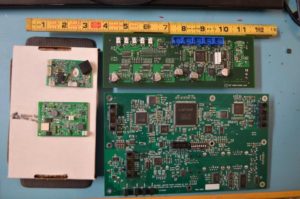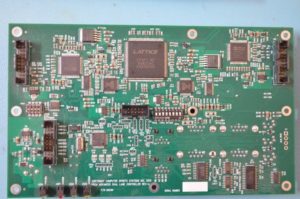Small electronic controllers show up in many of the devices that we use every day, including some that you might not expect. Electrical engineer Michael Form designs small, energy-efficient circuits for all sorts of applications, from industrial forges to soap dispensers. “Anything with electronics or that’s electrical,” he says, even a kitchen appliance or an audio amplifier, has some kind of controller to make it do what people want it to do.
Form describes his work as “embedded computing”: all of his projects use tiny microprocessors embedded in the circuits, rather than just circuit parts. It’s possible to build circuits for pretty complicated jobs without using microprocessors, but using them means that everything Form makes can be reprogrammed if he decides it should work differently. If you want something to run for five minutes instead of two, for instance, you can just “make a change with software without redoing all the hardware.” This is a new development in electrical engineering. “Twenty years or so ago,” Form says, “you might build a specific circuit to do a specific job. Nowadays, you might use a microprocessor and program it to do that job.”

Many of Form’s circuits live in battery-powered devices, so power consumption is very important in his job. Different microprocessors run at different speeds—faster ones can do calculations in less time, but they also use more power, so choosing the right processor for the job is important. He also considers other parts of a device that use power besides the processor, like the tiny motor in an automatic soap dispenser.
A tricky part of calculating power consumption is that it’s easy to find out how much power a microprocessor uses when it’s running, but processors often spend a lot of the time asleep, and when a processor is asleep it draws less power. Form estimates how much of the time a processor will spend awake—maybe a device will wake up on a timer every five minutes to check whether an event has happened—and uses his estimate to calculate its power requirements.

Form’s power-consumption calculations are also useful in making sure that his embedded circuits don’t overheat, since almost all the power that his circuits use ends up as heat energy, raising the temperature of the circuits. “You don’t want them to overheat,” says Form. “That’s when they fail.” He chooses all the parts for his circuits based partly on the amount of power that they draw, and he checks whether they use the correct amount of power with an oscilloscope. This is a tool that connects to two points in a circuit and makes very precise measurements of the voltage, resistance and current between them (power can be calculated from any two of these three values). Oscilloscopes are so precise that they can even measure the tiny amounts of electricity that a small battery-powered device, like Form’s soap dispenser, uses, calculating “currents down in the microamp range.” (A microampere is a millionth of an ampere.)
When he was in fourth grade, Michael’s parents gave him a telescope, which helped inspire him to explore science. He experimented with many different fields before settling on electrical engineering. “It’s still amazing to me to look up and see the stars and the planets and the moon,” he says. From astronomy he moved into chemistry, doing experiments in a home laboratory that he set up himself. Michael “always wore glasses, used rubber gloves, was careful to add things in the right order,” and “only one time, when [he ran] an exceptionally smoky experiment, did the neighbors call the police.”
Michael first discovered electrical engineering through ham radio, using amateur equipment to run a radio station (and to talk to his best friend) in middle school. His interest continued at New York City’s Stuyvesant High School, which was full of other kids interested in math and science. He joined a science program run by Columbia University, where he took challenging classes, including one in which he got to help build an electron microscope. “Some of them were over my head,” he says, “but it’s always good to have something that you can try and learn from.”
![A controller [Form designed] to operate valves and read sensors in a chromatographic column used to separate proteins for experimentation in the bio-pharmaceutical industry.](https://math4science.org/wp-content/uploads/2016/08/form4-300x199.jpg)
In college, Form chose to major in electrical engineering, which was a hard decision, because he was still interested in other fields, like biology. Still, he made his choice and dedicated himself to the field. Engineering was a big part of his life outside school, too. Thanks to his middle school amateur radio experience, he got a summer job working for a TV station that transmitted from an antenna on top of the Empire State Building.
After college, Form worked all sorts of jobs in electrical engineering. He helped design one of the first desktop graphics computers, the first ever electronic Chinese typewriter, a scoring system for bowling alleys and swipe-card security systems for buildings. All of these very different projects were accessible to someone with electrical engineering experience.
Today, Form is still designing small devices with embedded processors. He’s been working on a battery-powered tool that operators of industrial machines will use to measure how much their machines vibrate. Vibration is a good indicator of how much wear is put on the machines, so measuring vibration will help mechanics do maintenance on the machines that need them most, repairing them before they even break. Tiny electronic devices have become totally normal in our lives, and as Electrical Engineer Michael Form says, “someone has to design these things.”


